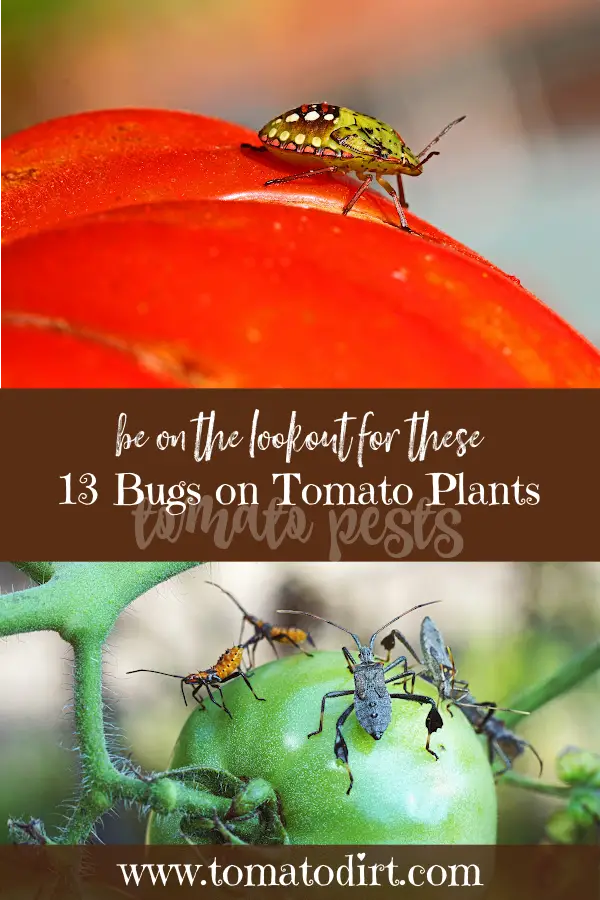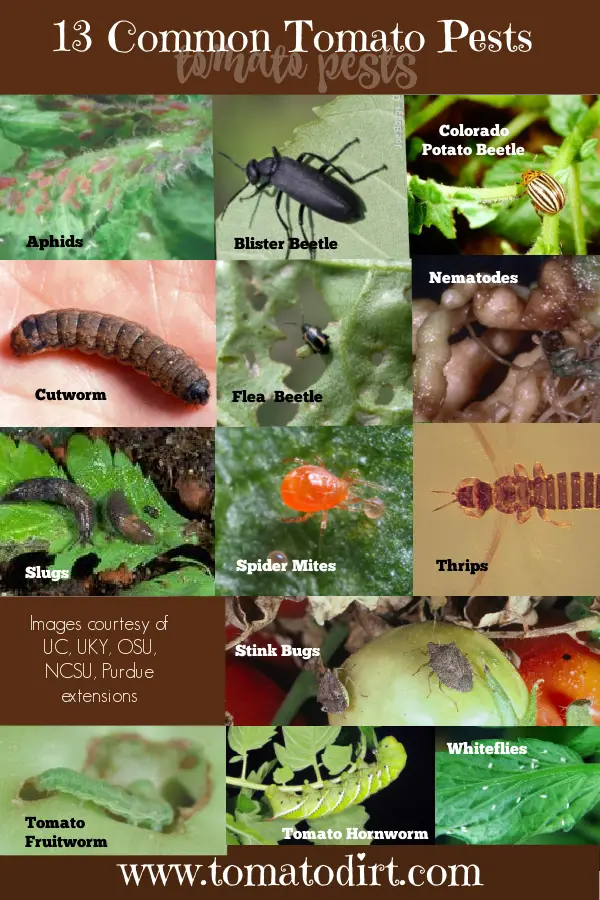FREE: 10 Must-Know Tomato Growing Tips Get The Guide
Read our affiliate disclosure here.
How to Identify 13 Common Bugs on Tomato Plants
Since 2010, Tomato Dirt has garnered 4.8+ million views, making it the web’s leading online source for growing tomatoes in the home garden. Award-winning writer and Tomato Dirt owner Kathy Widenhouse has helped thousands of home gardeners grow healthier tomatoes. Be one of them when you get Tomato Dirt’s Growing Guide here.
Updated 7.15.24
You’re on your way to a luscious tomato crop. But one day, you notice bugs on tomato plants. Or you see a trail of damage that tomato pests have left in their wake.
In a perfect world, you’d prevent the invasion of those bugs on tomato plants in the first place.
But the next best thing is to catch those marauders in the act – or soon after they’ve begun their dirty work – and nip them in the bud, so to speak. You want them off your plants and out of your garden before they wreak havoc on your crop and spread all kinds of nasty diseases.
A good way to identify bugs on tomato plants is by where they attack: the upper plant (including its leaves, stems, and fruit) and the lower plant and roots. Here’s how to recognize the 13 most common tomato pests and how they do their work.
Bugs on tomato plants: upper leaves and stems
1. Aphids
What they do: aphids suck out juices and nutrients from tomato leaves, stems, and fruits, stunting plant growth, causing leaves to curl, and making leaves turn to yellow. They secrete a white stick substance called honeydew which can lead to mold and powdery mildew on your tomato plants.
What they look like
Shape: tiny, pear-shaped
Color: green, gray, black, brown, yellow, or white
Size: 2-4 mm
Control
Apply water streams; insecticidal soap; neem oil; row covers; insecticide
2. Blister beetles
What they do: like other bugs on tomato plants, blister beetles chew holes in the foliage. But they travel in groups, so you’ll likely see a series of affected leaves. Their biggest damage, however, is to your skin. When crushed or even swatted, blister beetles release a chemical agent, cantharidin, which causes blistering on bare skin. Cantharidin also can burn or wilt tomato foliage.
What they look like
Shape: cylindrical with wings
Color: tan with gray or black stripes
Size: ½ inch long
Control
Control weeds; handpick – with gloves
3. Colorado potato beetle
What they do: larvae eat leaf matter but leave the veins, so you can recognize their invasion by skeletal or laced leaves. The Colorado potato beetle is attracted to other nightshades, too – peppers, eggplant, and potatoes.
What they look like
Shape: oval
Color: alternating yellow and black stripes.
Size: 3/8 – 1/2” long
Control
Handpick
4. Flea beetles
What they do: flea beetles feed on foliage, leaving round holes. New leaves or young plants are usually damaged first. While beetles may not destroy your tomato plants, they’ve got a reputation for spreading diseases that can – specifically, tomato wilt and tomato blight.
What they look like
Shape: shiny, cylindrical
Color: black, bronze, bluish, brown, tan, metallic gray. Some have stripes.
Size: tiny – 1/10” long
Control
Use sticky traps; apply diatomaceous earth on plants and the surrounding soil
5. Spider mites
What they do: spider mites thrive in hot, dry weather. They hide on the undersides of leaves and suck out the nutrients. You’ll first notice tiny white and yellow spots or itty-bitty holes on the leaves. Left unchecked, you’ll start to notice silky webbing around leaves and stems.
What they look like
Shape: dot
Color: red, brown, yellow, green
Size: microscopic – 1/50th inch. You’ll only notice spider mites by affected leaves, stems, and webbing left in their wake.
Control
Apply water streams; insecticidal soap; neem oil
6. Thrips
What they do: while thrips don’t attack tomatoes directly, they are a tomato spotted wilt virus carrier as larvae and transmit it to plants as adults, when they’re feeding. Thrips prick tomato leaves, suck the contents, and transfer the virus in the process.
What they look like
Shape: cigar-shaped
Color: yellow, green, grey, or black
Size: itty-bitty – about 1/25” long
Control
Apply horticultural oil, insecticidal soap
7. Tomato hornworm and tobacco hornworm
What they do: the tomato hornworm and tobacco hornworm (easily confused with each other) both attach themselves to the underside of a tomato’s leaves, making it difficult to find them right away. They feast on both tomato leaves and green tomatoes, leaving stripped stems, wilted leaves, and leave dark droppings.
What they look like
Shape: cylindrical; caterpillar-shaped, with horn
Color: green, which allows them to blend in with the tomato plant
Markings: tomato hornworm – eight, V-shaped white or yellowish strips across the torso; tobacco hornworm – seven, straight or diagonal white strips edged with black across the torso
Size: both can grow to be 3-4 inches long
Control
Handpick; apply natural and chemical insecticide
8. Whiteflies
What they do: whiteflies hide on the undersides of tomato leaves, where they insert their snouts, extract nutrients from leaves, and cause the foliage to wither and die. There are 1,200 types of whiteflies, but the greenhouse whitefly and silverleaf whitefly are the most common on tomato plants.
What they look like
Shape: triangular, with wings
Color: white
Size: tiny – 1/16 of an inch
Control
Apply insecticidal soap
Bugs on tomato plants: lower stem and roots
9. Cutworms
What they do: early in the season, the cutworm gobbles up stems of tomato seedlings at the soil line. Later in the season, this tomato pest nibbles holes on the surface of tomatoes near the ground.
What it looks like
Shape: caterpillar
Color: gray, brown, or black
Markings: smooth outer skin. Cutworms curl up into a “C” shape when they’re not at work
Size: up to 2 inches long
Control
Handpick
10. Nematodes
What they do: also called root knot nematodes, these tomato pests live underground and feed off the nutrients pumped through tomato roots. Your tomato plants will yellow, be stunted, and simply decline – and you may not know why unless you find 1-inch galls or swollen areas around the roots beneath the soil where nematodes reproduce.
What they look like
Nematodes are microscopic; about one-tenth the size of a pinhead. Galls are abnormal swellings or localized outgrowths on the plant’s roots.
Control
Rotate crops
11. Slugs and snails
What they do: slugs and snails consume leaves, beginning at the outer edges, through to stems and even fruit. They leave behind a trail of mucus. On fruit, they leave irregular holes.
What they look like
Shape: cylindrical caterpillar-shape; 2 sets of feelers; snails have outer shell
Color: brown, gray
Size: 2- 7 inches long
Control
Handpick; trap
Bugs on tomato plants: fruit
12. Stink bug
What it does: a stink bug inserts its snout underneath tomato skin and injects an enzyme that turns the localized area into liquid, which the bug then drinks. A stink bug leaves discolored areas on the fruit.
What it looks like
Shape: shield-like
Color: variations of brown, gray, or green
Markings: some have yellow, red, or pink markings
Size: about ½ inch long
Control
Control weeds; handpick; use insecticide
13. Tomato fruitworm
What it does: the tomato fruitworm attacks a tomato by tunneling leaves, stems, and fruit. It consumes the tomato interior and leaves a cavity filled with fluid and droppings.
What it looks like
Shape: caterpillar (in larvae stage)
Color: cream, yellow, green, reddish, or brown
Markings: pale stripes and/or black spots; hairy
Size: about 1 ½ - 2 inches long
Control
Apply neem oil; insecticidal soap; insecticide
Other bugs on tomato plants
There are plenty of other tomato pests that work damage on your tomato plants: the potato wireworm, tortoise beetles, wireworms, stalk borers, psyllids, leaf miners, tomato pinworm, cabbage looper, tobacco budworm … the types of bugs that attack tomatoes number in the dozens to hundreds.
But you can fight them. The key is to know what to look for, as shared here.
Then match their damage with their name and the way to control them. Your tomato plants will thank you by yielding a healthier, more productive crop.
More about tomato pests
Aphids on tomato plants: how to identify and control them ...
Tomato hornworm: how to identify and control it ...
Tomato fruitworms: how to identify and control them ...
Tomato worms-cutworms: keep them away with stem collars ...
Stink bugs: how to identify and control them on tomato plants...
Pests that attack tomatoes in containers ...
How to identify and control indoor tomato pests ...
Get more tips on our Tomato Pests Pinterest board...
Return from 13 Common Bugs on Tomato Plants to Tomato Dirt home
As an Amazon Associate and Rakuten Advertising affiliate I earn from qualifying purchases.
SHARE THIS PAGE:
FREE! 10 Must-Know Tomato Growing Tips: 20-page guide
Get yours here:





